#Battle of Inverkeithing
Explore tagged Tumblr posts
Link
Wikipedia article of the day is Battle of Inverkeithing. Check it out: https://ift.tt/NZzFf60
0 notes
Text


May 4th* 1658 General George Monk proclaimed the Protectorate at Mercat Cross.
Some sources say 5th
Cromwells new model army had invaded Scotland, winning decisive battles against the Scots at battles of Dunbar and Inverkeithing, this Proclamation in Edinburgh was made to draw a line under Wars of the Three Kingdoms. Oliver Cromwell was installed as the Lord Protector of the Commonwealth of England, Scotland and Ireland and he ordained that the People of Scotland were pardoned for any crimes they might have committed during the preceding wars and that there would be not further financial or other punishments.
There were of course exceptions, any Royalty were still to be held to account as were over two dozen Scottish nobles and generals including David Leslie Lieutenant-General of the Scottish Army. Over 70 other nobles who had been fined by Cromwell were still held to those penalties.
Scotland was placed under English military occupation with General Monck as military governor of the country. The English army had been able to suppress the Scottish resistance to the occupation with relative ease and the occupation, with sporadic but ineffective resistance, this continued until 1660 when Monk was instrumental in the restoration of the monarchy and Charles II was invited to take the throne.
9 notes
·
View notes
Photo
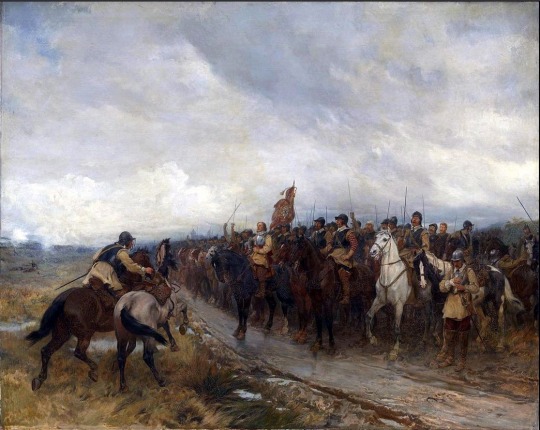
The Battle of Dunbar was fought between the English New Model Army, under Oliver Cromwell, and a Scottish army commanded by David Leslie, on 3 September 1650 near Dunbar, Scotland. The battle resulted in a decisive victory for the English. It was the first major battle of the 1650 invasion of Scotland, which was triggered by Scotland's acceptance of Charles II as king of Britain after the beheading of his father, Charles I on 30 January 1649.
After Charles I's execution, the English Rump Parliament established a republican Commonwealth in England. When their erstwhile ally, Scotland, recognised Charles II as king of all of Britain on 1 May 1650 and began recruiting an army to support him, the English dispatched the New Model Army, under the command of Cromwell. The army crossed into Scotland on 22 July, with a force of over 16,000 men. The Scots withdrew to Edinburgh, stripping the land of provisions. Cromwell attempted to draw the Scots out into a set piece battle, but they resisted, and Cromwell was unable to break through their defensive line. At the end of August, with his army weakened through disease and lack of food, Cromwell withdrew to the port of Dunbar. The Scottish army followed and took up an unassailable position on Doon Hill, overlooking the town. On 2 September, the Scots advanced towards Dunbar, and the English took up positions outside the town. The English army was greatly weakened by sickness and lack of food, while many of the Scots' most experienced men had been dismissed in religious purges.
Before dawn on 3 September, the English launched a surprise attack on the Scots, who were poorly prepared. The fighting was restricted to the north-eastern flank with the main contingents of English and Scottish cavalry fighting inconclusively, as did the English and Scottish infantry. Due to the terrain Leslie was unable to reinforce the fighting, while Cromwell used his last reserve to outflank the Scots. The Scottish cavalry broke and routed; the Scottish infantry made a fighting retreat but suffered heavy casualties. Between 300 and 500 Scots were killed, approximately 1,000 wounded and at least 6,000 were taken prisoner from an army of 12,500 or fewer.
After the battle, the Scottish government took refuge in Stirling, where Leslie rallied what remained of his army. The English captured Edinburgh and the strategically important port of Leith. In the summer of 1651, the English crossed the Firth of Forth to land a force in Fife; they defeated the Scots at Inverkeithing and so threatened the northern Scottish strongholds. Leslie and Charles II marched south in an unsuccessful attempt to rally Royalist supporters in England. The Scottish government, left in an untenable situation, surrendered to Cromwell, who then followed the Scottish army south. At the Battle of Worcester, precisely one year after the Battle of Dunbar, Cromwell crushed the Scottish army, ending the war.
https://en.wikipedia.org/wiki/Battle_of_Dunbar_(1650)
1 note
·
View note
Text
Scottish Sailors and Commanders
Although some may wonder but there was actually a Scottish Navy which was founded in the 11th century and peaked at the end of the 15th at the beginning of the 16th century. The troop not only grew to 38 ships, but the ships themselves were also successfully deployed in Scottish waters by English, Danish and Portuguese buccaneers.
James IV also added new shipyards and under his rule the first Lord High Admiral position was established. Most importantly, the Scots built the largest warship in the world at the time. The 240 foot long, 1,000 tonne Great Michael had a crew of 1,000 men and carried the famous Mons Meg cannon, a 22 inch giant of a weapon that is distinguished as the largest cannon in history. Founded in 1512, the Scots found Michael far too expensive to maintain. Within two years it was sold to France. Its new owners renamed it The Big Ship of Scotland and released it to the English. Later she fought in the Battle of Solent in 1545 and sunk an English ship.
Scotland relied largely on buccaneers in subsequent wars with England, but during the 19th century Scottish ships fought alongside English ships in various wars against France and Spain. In the 18th century the Scottish naval forces were united to those of Great Britain.
Perhaps this merger is also an explanation for the fact that there are very few representations and images of Scottish sailors or Commanders.
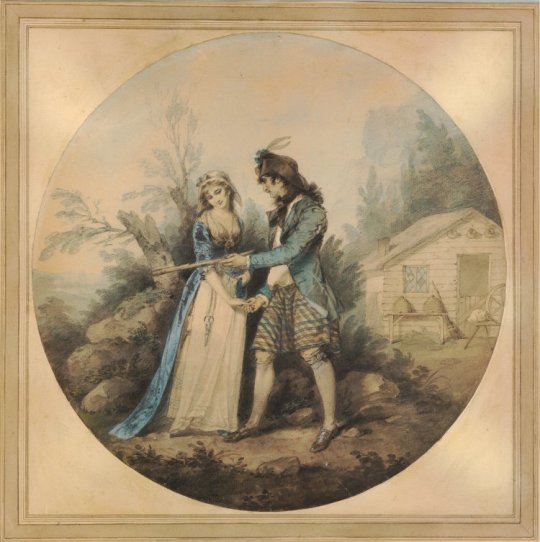

A scotish sailor wearing a kilt- Sailor’s farewell by John Hodges Benwell 1746-1800
Now it may be maybe only my impression but most of the time when i works my way through the history of the Royal Navy. Scottish personalities are mentioned only marginally unless they are really such an outstanding personality that you simply can't ignore them. like e.g. my all time favorite Lord badass Cochrane
But there were some and from the Commanders there were some really successful ones.
There we have a few:
Alexander Selkirk (1676-1721)

Born in Lower Largo, Fife, Alexander Selkirk spent a number of years as a buccaneer on the South Seas, but it was his actions on dry land that lent him notoriety. In 1703, on a privateering expedition, Selkirk argued with the commander about the vessel’s seaworthiness and chose to be put ashore on an uninhabited island rather than sail any further. Selkirk was rescued four years later, by which time he had developed his hunting and wood crafting skills. Many believe that Daniel Defoe based his fictional character, Robinson Crusoe, on Selkirk.
Samuel Greig (1736-1788)

Greig was born in Inverkeithing, Fife, and entered the Royal Navy early. He soon became renowned for his skill, zeal and attention to detail, and quickly rose to Lieutenant. He joined the Russian navy after the Russian Court asked the British to send skilled naval officers to help them and he soon rose to Captain. Greig distinguished himself first at the Battle of Chesma in 1770, where he bore down with fire ships and destroyed the entire Turkish fleet, and the Battle of Hogland against the Swedes in 1788. It was in the latter that Greig, or Count Orlov as he was then, contracted fever and died. He received a full Russian state funeral in Talinn.
Lord Thomas Cochrane the Seawolf (1775-1860)
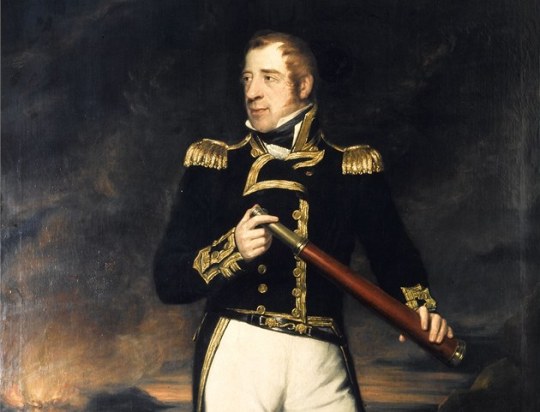
Born near Hamilton, South Lanarkshire, on 14 December 1775, Thomas Cochrane became the model for Hornblower and Jack Aubrey. During the Napoleonic Wars, Lord Thomas Cochrane’s ship, Speedy, captured 53 French ships and £75,000 in prize money in 13 months, but in 1814 he was dismissed when imprisoned for stock exchange fraud. A daring buccaneer, Cochrane successfully led the rebel navies in Chile, Brazil and Greece before being reinstated as a Rear-Admiral in 1832.
Admiral Andrew Wood (1450-1538)
‘Scotland’s Nelson’ was born in Upper Largo in Fife and owned two ships trading from Leith. Wood was also a privateer who preyed on English ships, and was the personal sea captain to James III. In 1488, Wood captured five English privateers and became an admiral in the Royal Scots Navy. In 1511, he took command of the Navy’s flagship, Great Michael, then the largest ship in Europe, and commanded the Scottish fleet against the English in 1513.
Charles John Napier (1786-1860)

Napier’s distinguished 60-year naval career included service in the Napoleonic Wars, Syrian War, Crimean War and the Anglo-American War of 1812-15. An innovator concerned with the development of iron ships, he was also a Liberal MP. During the Syrian War, Napier negotiated peace with Egyptian ruler Muhammad Ali. ‘I do not know if I have done right in settling the eastern question,’ he wrote to Lord Minto. Napier was knighted in 1840 and became aide-de-camp to Queen Victoria in 1841. He had three nicknames: Black Charlie, because he was 14 stone and walked with limp; Mad Charlie, because of his eccentric behaviour; and Dirty Charlie, for his unsuitable clothing.
Aleksey Greig (1775-1845)

Son of Samuel Greig, Aleksey Greig studied at the Royal High School of Edinburgh and on HMS Culloden under Admiral Trowbridge. After serving in the Royal Navy from 1785-1796 he returned to Russia to take part in expeditions against revolutionary France. In 1801 he was banished to Siberia for arguing with Emperor Paul about the treatment of British prisoners, but distinguished himself in 1807 during the Battle of Athos and Battle of the Dardanelles. In 1816 he was put in command of the Black Sea Fleet at Sevastopol.
John Paul Jones (1747-1792)

The son of a gardener, Jones was born in Kirkcudbright, began his naval career aged 13 as an apprentice, and sailed aboard a number of British merchant and slave ships. The vicious flogging of one of his sailors and the killing of a member of his crew over a dispute over wages tarnished Jones’ reputation, but it was this ruthless streak that led to his triumph fighting for the American navy against the British during the Revolutionary War. In that conflict he distinguished himself in American and British waters, becoming a hero of the American revolution. Jones later served in the Russian Imperial Navy and retired to Paris in 1790, where he died two years later.
@bantarleton i told you i do it ;) and to all others, the list may of course be extended
122 notes
·
View notes
Photo

Archibald was baptized 24 August 1739 at the seat of Clan Campbell, Inveraray, Scotland. He grew up with his family at Dunderave Castle, and enjoyed the patronage of both Archibald Campbell, 3rd Duke of Argyll and Henry Dundas, 1st Viscount Melville.
Educated at Glasgow University, and afterwards at the Royal Military Academy, Woolwich. In 1758, he was commissioned into the Royal Engineers. He served with them in the Seven Years' War and was wounded at the Siege of Quebec. He participated in a number of raids along the coast of France, as well as in expeditions in the West Indies. A decade later, in 1768, Colonel Campbell, was made chief engineer of the British East India Company at Bengal, and was successfully employed by the company to head the works on Fort William in Calcutta.
In Calcutta, Campbell laid the foundation of his wealth. With Captain Henry Watson, he privately invested in a dockyard at Kidderpore, and the two men acted as contractors for building and repairing ships until the government bought their concern. He also made a fortune trading in silk. Campbell used his wealth to become a major landowner in his native Argyll. He spent over £30,000 purchasing the estates of Danna, Inverneill, Knap, Taynish, and Ulva. He also purchased the houses of Inverkeithing and Queensferry.
In 1774, after an unusually bitter electoral battle with Colonel James Masterton (1715–1777), of Newton, Colonel Archibald Campbell (now styled 'of Inverneill') became the Member of Parliament for the Stirling Burghs, aided by his guardian, Viscount Melville. James Boswell acted as Campbell's legal advisor.
Following his exciting electoral victory, Colonel Campbell left his elder brother, Sir James Campbell (1737–1805) of Killean, to keep his parliamentary seat warm and sailed for America in command of the 71st Regiment of Foot, Fraser's Highlanders, where the American Revolutionary War was in progress. In 1776, after a battle aboard a vessel in Boston Harbor, Campbell was captured by the Americans and held prisoner until 1778.
Campbell's capture coincided with the British capture of the American Patriot hero Ethan Allen and the American General Charles Lee. Rumours spread that they were being mistreated by the British, which had a direct effect on Campbell. In February 1777, from Concord Jail, an outraged Campbell complained to Viscount Howe of his situation. There then ensued complaints and correspondence between Howe and George Washington on Campbell's behalf.
By the following month Washington intervened and Congress protested that it had not intended to cause undue suffering to Campbell. By May, Campbell was living at the jailer's tavern, a marked improvement to his previous solitary confinement. Soon afterwards he was granted total freedom within the confine of the town of Concord, and it should be noted that during these years as a prisoner of war he was able to purchase the Knap estate back in Argyll. On 6 May 1778, he was finally released in exchange for Ethan Allen.
Six months after his release, Campbell was ordered to lead 3,000 men from New York to Georgia, and in late December his army won the Battle of Savannah, followed by another victory at Augusta, Georgia. Contemporaries on both sides paid tribute to the humanity and restraint shown by Campbell. The American patriot Alexander Green, one of Lee's Legion and aide-de-camp to Major-General Nathanael Greene referred to Campbell's concern for the civil population and lack of bitterness towards his former captors. He also revealed how the Patriots feared Campbell as a commander of great ability. Greene related of Campbell:
As conqueror of Savannah, his immediate care was to soften the asperities of war, and to reconcile to his equitable government, those who had submitted, in the first instance, to the superiority of his arms. Though but lately released from close and rigorous confinement, which he had suffered in consequence of indignities offered to General Charles Lee, a prisoner at New York, he harboured no resentments, and considered his sufferings rather the effect of necessity, than wilful persecution. Oppression was foreign to his nature, and incompatible with his practice. He made proper allowance for an attachment to cherished principles nor with-held his applause from those who bravely supported them. He used no threats to gain proselytes, no artifice to ensnare them. Such of the inhabitants as voluntarily made a tender of service, were favourably received; but he was ever disinclined to invite them to take up arms in the British cause, lest in the fluctuating councils of his governments, he should lead them to destruction. He had too frequently seen them lavished of professions of permanent support, leaving their deluded adherents to the mercy of the government, which, in an evil hour, they had abandoned. The friends of out[our?] independence had everything to dread from his wisdom and humanity, but their alarm was short of duration. Lieutenant Colonel Campbell had too nice a sense of honour to be made instrument of injustice and oppression, and he was speedily called upon to relinquish his command, to a superior, less scrupulous and better disposed to second the harsh measures of the Commander in Chief.
He became provisional governor of Georgia then and named Jacques Marcus Prevost his lieutenant and successor before returning to England.
Returning to England, in July 1779,[2] he married Amelia (1755–1813), daughter of Allan Ramsay of Kinkell, Principal Painter in Ordinary to George III. Amelia Campbell's mother, Margaret (1726–1782), was the eldest daughter of Sir Alexander Lindsay of Evelick and Hon. Amelia Murray, the sister of Amelia Campbell's influential great uncle and guardian, William Murray, 1st Earl of Mansfield. Mrs Campbell was the niece of Admiral Sir John Lindsay, and by him a first cousin of Dido Elizabeth Belle.
At a time of great importance, Campbell (now a major-general in the army) was appointed Governor of Jamaica in 1782. The British forces in America were faring ill: the French had joined the insurgents and threatened the British West India Islands, of which they captured Tobago, St. Eustatius, St. Kitts, Nevis and Montserrat. But Campbell laid his plans so well. He was so successful in raising native troops, and was so untiring in his vigilance that the French did not dare attack Jamaica without re-inforcements.
At the same time, Campbell did what he could to assist the British troops in America by sending them information, re-inforcements and supplies. By lending some of his troops to serve as marines, he materially aided Admiral Rodney in his great victory over François Joseph Paul de Grasse at the Battle of the Saintes, saving Jamaica from a French invasion.
Campbell's wife, Amelia, and her sister, only just managed to join him in Jamaica. The crossing was perilous and their convoy came under fire from a joint French and Spanish fleet, and their ship was the only one to get through. On returning from Jamaica, Campbell was awarded as Knight of the Order of the Bath.
In India, Madras was exhausted after the war against Mysore, and no serious military operations were undertaken until renewed hostilities against that state became inevitable at the end of 1789. In 1786, Campbell, who was now a well known and highly respected figure, was appointed commander-in-chief and governor of Madras. Throughout his term of office, the country had a rest from the devastating wars, and so he devoted himself to the development of peaceful institutions.
He founded a military board which absorbed the duties of the Committee of Works; a hospital board, a board of revenue and a board of trade. He reorganized the police, established a stock exchange and a bank. He built an astronomical observatory and constituted an orphan asylum. In fact, there was hardly a department of the civil administration in which he did not labour to secure improvement and order. Madras sustained a serious loss when, overcome by illness, he was forced to leave India in February 1789, retiring from the post of governor in 1790.
On returning home, he acquired the office of Usher of the White Rod. The Institution of Royal Engineers described Campbell as "the most brilliant of the engineers who served in India during the eighteenth century". Following a cold caught coming up from Scotland, he died the following year, 31 March 1791, at his newly purchased London home on Upper Grosvenor Street, bought from the Duke of Montrose. He was only fifty-two. His fortune, land and political titles passed to his two brothers, and his wife was given £25,000.
Campbell and his wife died without children, and they were both buried at Westminster Abbey next to Handel's Monument in Poets' Corner. Also buried there was his nephew, Lt.-General Sir James Campbell of Inverneill and his wife's kinsmen, the Earl of Mansfield and Admiral Lindsay.
#Archibald campell#british army#history#military history#british empire#redcoat#campbell#clan campbell#scotland#scottish#Scottish history#18th century#seven years war#7 years war#French and indian war#siege of quebec#battle of savannah#savannah#american revolution#revwar#american war of independence
23 notes
·
View notes
Text
Researching Maclean
This ancient surname is of early Gaelic origins. It is derived from 'Maccbethad' (the modern Scottish 'Macbeth'), meaning 'son of life', or 'man of religion', which hardly fits in with Shakespeares interpretation! Today the name is quite numerous in North East Ulster and it is found in a wide variety of spellings which include McVeigh, MacVaugh, MacVagh, MacVaugh, McVey, MacBey, etc.. However its probable place of origin was in the Scottish Islands of Mull and Islay where in the medieval times it is believed that the Clan were the hereditary physicians to the region. They were also, it is said, great historians, and collectors of ancient manuscripts. The recordings include Father Patrick Macabeath (1541), Bishop of Armagh, Ireland, whilst John McVeigh was a prominent rebel in the 1798 rebellion of Ireland and was executed at Baltinglass. Church recordings include the following examples, Leiticia McVeagh who married Thomas Gordon on the April 1st 1785, at Edinburgh Parish, Edinburgh, whilst Anna McVey, aged 25, is recorded as being a 'Famine Emigrant' who sailed on the ship 'Manchester' from Belfast to New York, on September 25th 1846. The first recorded spelling of the family name is shown to be that of John Macvay, which was dated 1504, in the Exchequer Rolls of Scotland, during the reign of King James 1V of Scotland, 1488 - 1513. Surnames became necessary when governments introduced personal taxation. In England this was known as Poll Tax. Throughout the centuries, surnames in every country have continued to "develop" often leading to astonishing variants of the original spelling. Read more: https://www.surnamedb.com/Surname/McVeagh#ixzz63fqgwrvR
Maclean: Tradition tells that this powerful clan was descended from Gilleain-nan-Tuagh (Gillian of the Battle Axe), a descendant of the Kings of Dalriada. Gillian fought against King Haakon of Norway at the Battle of Largs in 1263. The first recorded mention of the Macleans of Duart is in a Papal Dispensation of 1367, which allowed the Maclean Clan Chief to marry Mary MacDonald, the daughter of the Lord of the Isles. The Isle of Mull off Scotland’s northwest coast was the principal home of the clan, with the MacDonald dowry supplying the funds to purchase substantial parcels of the island. The Macleans supported King Charles I against the Parliamentarians. Sir Hector Ruadh Maclean and five hundred of his clansmen were slain at the Battle of Inverkeithing in 1651 by Cromwell’s New Model Army. In 1876 Sir Harry Maclean resigned his commission in the British Army to join the army of the Sultan of Morocco. He enjoyed a romantic career and became military leader and personal advisor to the Sultan. Family motto – Virtue Mine Honour.
https://www.historic-uk.com/HistoryUK/HistoryofScotland/The-Great-Clans-of-Scotland/
0 notes
Text
My Maternal 8th. Great Granduncle, Sir Hector MacLean, 2nd. Baronet of Morvern, 18th. Clan Chief of MacLean
My Maternal 8th. Great Granduncle, Sir Hector MacLean, 2nd. Baronet of Morvern, 18th. Clan Chief of MacLean
Sir Hector MacLean, 2nd. Baronet of Morvern, 18th. Clan Chief of Clan MacLean
Born: 1626 Duart Castle, Argyll, Scotland
Died: 20 July 1651 in the Battle of Inverkeithing, Inverkeithing, Argyll, Scotland
Sir Hector MacLean, 2nd Baronet (c.1626-1651) was the 18th Clan Chief of Clan MacLean from 1649 to 1651. He died without leaving a son as an heir. Biography: Hector was the son of Sir Lachlan…
View On WordPress
0 notes
Text
Carl Vickers Ready To Start Championship Battles
Inverkeithing | http://dlvr.it/NgnB0Q
0 notes
Text
New Post has been published on Superbike News
New Post has been published on http://superbike-news.co.uk/wordpress/carl-vickers-ready-start-championship-battles/
Carl Vickers Ready To Start Championship Battles
This weekend will see Dunfermline based rider Carl Vickers #87 take to the track for the first time this season in the Thundersport GB Golden Era Supersport Championship at Donington Race Circuit.
Following an impressive year in 2016 with numerous top 5 and top 10 finishes on the Blackbird Corporate Yamaha R6, Vickers is focused on podium finishes. The bike has been worked on by the team at Delkevic UK, who have fitted the bike with a new prototype exhaust system. The exhaust system will be tested for the first time on Friday and Carl and the team are looking forward to seeing how it will perform.
Carl said “it has been a long winter season. I am really excited about this weekend and getting back out on track. I have received a huge amount of support from my sponsors, Fucsh Silkolene who have supplied me with all the oils and lubricants for the bike, Jacksons Bikes in Kelty who have done all of the team bodywork, Lime Salon in Inverkeithing who continue to support me and Blackbird Corporate Ltd based in Dunfermline, who have been with me since day one. My focus this year is to gain as many podium finishes as possible. I was getting really close last year and with the new modifications we have made over the winter I am positive that I can get the results I am looking for.”
Following this weekend’s racing at Donington, Carl will be taking to the track next weekend at Croft in the first round of the North East Club Pre-Injection Championship.
0 notes
Text



The Battle of Inverkeithing, took place on the 20th of July 1651.
The New Model Army led by Parliamentary officer John Lambert defeated a force of Scottish Royalists under the authority of Sir John Browne.It was a decisive encounter of Cromwell’s Scottish War, ending a long strategic deadlock with the Scottish Royalist army under King Charles II, and allowing them to conquer Scotland.
Oliver Cromwell, England’s Lord Protector, had ordered Lambert to cross the Firth of Forth into Fife with 4,500 troops and attack David Leslie, Lord Newark’s supply lines. In response to this threat, Leslie had sent Browne’s 4,000 men-at-arms to drive Lambert back over the Firth. The hostilities began with skirmishes at Inverkeithing.
As Lambert’s Roundheads moved northward, a major battle took place on the flat terrain south of Pitreavie House. In the aftermath, the Scots had suffered a terrible defeat with up to 2,000 killed, many wounded and 500 taken prisoner. One of the prisoners was the Royalist commander himself, Sir John Browne. Another notable casualty was our own Sir Hector MacLean of Duart who tragically died along with some 760 of the gallant MacLean contingent.
The day was remembered very vividly for several generations, the Annals of Dunfermline record that….“A rill, traversing the valley, called the Pinkerton-burn,” tradition says, “ran with blood for several days, and the appearance of the little mounds, or heaps of the slain, resembled a hairst field of stooks of corpses.”
In honour of Sir Hector and his men, the Clan MacLean Heritage Trust raised this monument on the site of the battle - exactly 350 years later - on the 20th of July 2001.
4 notes
·
View notes
Photo

The Anglo-Scottish war (1650–1652), also known as the Third Civil War, was the final conflict in the Wars of the Three Kingdoms, a series of armed conflicts and political machinations between Parliamentarians and Royalists.
The 1650 English invasion was a pre-emptive military incursion by the English Commonwealth's New Model Army, intended to allay the risk of Charles II invading England with a Scottish army. The First and Second English Civil Wars, in which English Royalists, loyal to Charles I, fought Parliamentarians for control of the country, took place between 1642 and 1648. When the Royalists were defeated for the second time the English government, exasperated by Charles's duplicity during negotiations, had him executed on 30 January 1649. Charles I was also, separately, the king of Scotland, which was then an independent nation. The Scots fought in support of the Parliamentarians in the First Civil War, but sent an army in support of the king into England during the Second. The Parliament of Scotland, which had not been consulted before the execution, declared his son, Charles II, King of Britain.
In 1650 Scotland was rapidly raising an army. The leaders of the English Commonwealth government felt threatened and on 22 July the New Model Army under Oliver Cromwell invaded Scotland. The Scots, commanded by David Leslie, retreated to Edinburgh and refused battle. After a month of manoeuvring, Cromwell unexpectedly led the English army out of Dunbar in a night attack on 3 September and heavily defeated the Scots. The survivors abandoned Edinburgh and withdrew to the strategic bottleneck of Stirling. The English secured their hold over southern Scotland, but were unable to advance past Stirling. On 17 July 1651 the English crossed the Firth of Forth in specially constructed boats and defeated the Scots at the Battle of Inverkeithing on 20 July. This cut the Scottish army at Stirling off from its sources of supply and reinforcements.
Charles II, believing that the only alternative was surrender, invaded England in August. Cromwell pursued, few Englishmen rallied to the Royalist cause and the English raised a large army. Cromwell brought the badly outnumbered Scots to battle at Worcester on 3 September and completely defeated them, marking the end of the Wars of the Three Kingdoms. Charles was one of the few to escape. This demonstration that the English were willing to fight to defend the republic and capable of doing so effectively strengthened the position of the new English government. The defeated Scottish government was dissolved and the kingdom of Scotland was absorbed into the Commonwealth. Following much in-fighting Cromwell ruled as Lord Protector. After his death, further in-fighting resulted in Charles being crowned King of England on 23 April 1661, twelve years after being crowned by the Scots. This completed the Stuart Restoration.
https://en.wikipedia.org/wiki/Anglo-Scottish_war_(1650%E2%80%931652)
0 notes
Text
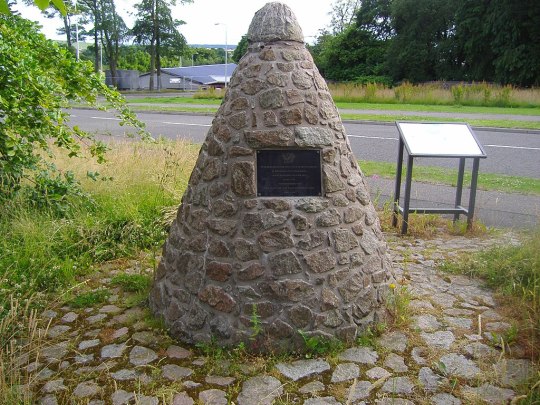
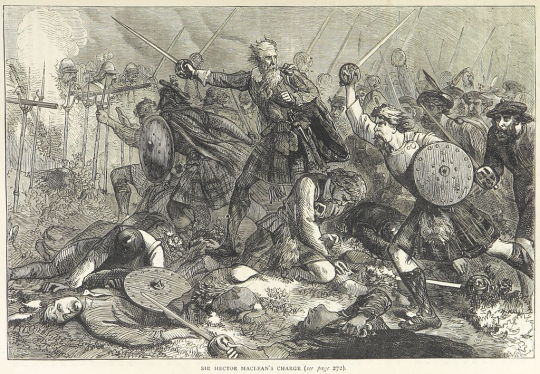
July 20th 1651 saw The Battle of Inverkeithing when Royalist force supporting Charles II failed to halt advance of army of Oliver Cromwell heading for Perth.
It was during the night or early morning of 16th /17th July 1651 that the troops of Oliver Cromwell’s New Model Army landed on the north shore of the Forth in the vicinity of Inverkeithing Bay. Whilst they had inflicted a heavy defeat on the Scottish army at Dunbar on 3rd September 1650, they had been thwarted by attempts to advance further into Scotland. Cromwell came to the conclusion that Fife was the key and by 20th July, 4,500 of Cromwell’s Parliamentarian force were dug in on Ferry Hills, whilst a Scottish force of a similar size had grouped at Castland Hill. The threat of Scottish reinforcements coming from Stirling provoked Cromwell’s Parliamentarians to attack and force the Scottish infantry to retreat north towards Pitreavie Castle.
On land close to the Castle, the Scottish infantry made a final stand but were soon overwhelmed by the more experienced Parliamentarians who had the additional advantage of cavalry. The Scots suffered heavy losses. This became known as The Battle of Inverkeithing (sometimes The Battle of Pitreavie) and was the last major battle of the Wars of the Three Kingdoms in Scotland. From 1652, Scotland was wholly under control of Cromwell’s Protectorate.
Of course the battle was and straightforward as this, there are always stories within the battles themselves;
Clan Maclean of of Duart, Mull was commanded by their chief, Sir Hector, they found themselves surrounded by superior enemy forces. The clansmen fought fiercely in defence of their chief, calling out, “Fear eile airson Eachainn!” (Another for Hector!), he was supported and covered from their attacks by these intrepid men; and as one brother fell, another came up in succession to cover for him, seven brothers of the clan sacrificed their lives in defence of their leader, they were traditionally Hector’s foster-brothers. He too was killed in the battle that day.
The first photo shows the monument at Pitreavie, it reads
Battle of Inverkeithing Memorial
“Near here Sir Hector Maclean of Duart was killed at the Battle of Inverkeithing along with some 760 of his men. 20 July 1651. Another for Hector!*
Erected by the Clan Maclean Heritage Trust 20 July 2001 The day was remembered very vividly for several generations, the Annals of Dunfermline record that….“A rill, traversing the valley, called the Pinkerton-burn,” tradition says, “ran with blood for several days, and the appearance of the little mounds, or heaps of the slain, resembled a hairst field of stooks of corpses.” *harvest field of stacked sheaves
9 notes
·
View notes
Text

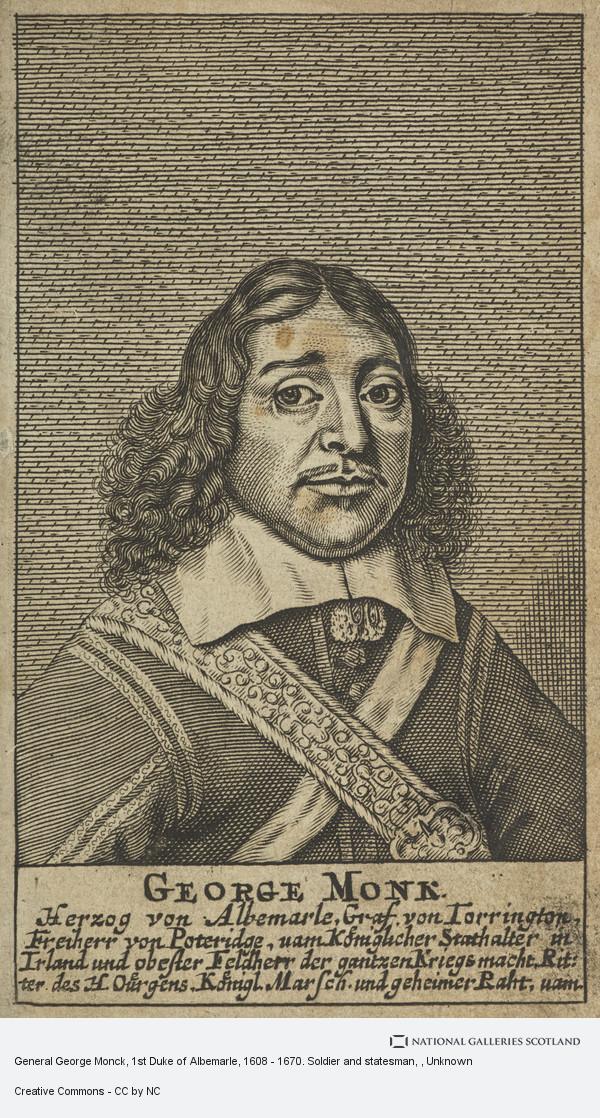
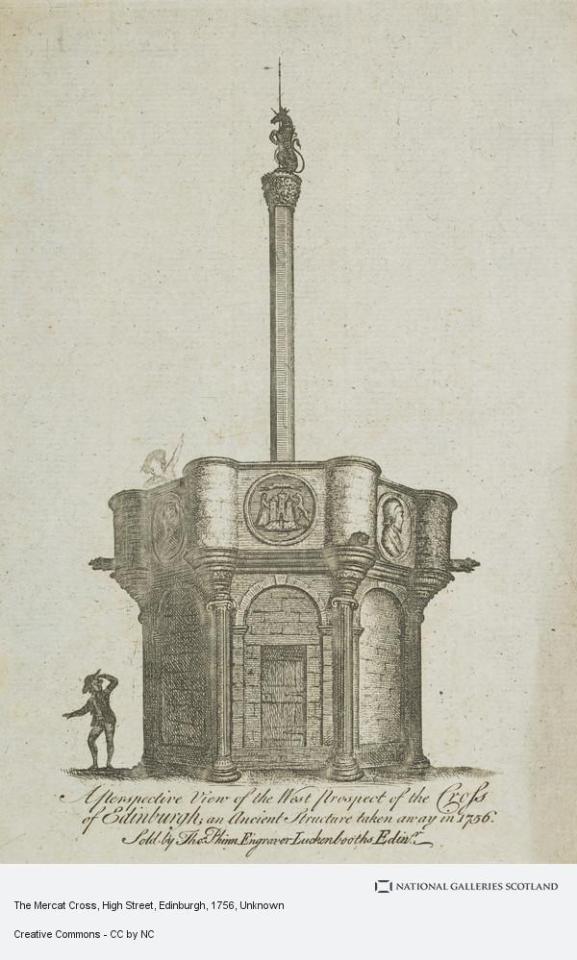

On May 4th 1658 General George Monk proclaimed the Protectorate at Mercat Cross.
Cromwells new model army had invaded Scotland, winning decisive battles against the Scots at battles of Dunbar and Inverkeithing, this Proclamation in Edinburgh was made to draw a line under Wars of the Three Kingdoms. Oliver Cromwell was installed as the Lord Protector of the Commonwealth of England, Scotland and Ireland and he ordained that the People of Scotland were pardoned for any crimes they might have committed during the preceding wars and that there would be not further financial or other punishments.
There were of course exceptions, any Royalty were still to be held to account as were over two dozen Scottish nobles and generals including David Leslie Lieutenant-General of the Scottish Army. Over 70 other nobles who had been fined by Cromwell were still held to those penalties.
Scotland was placed under English military occupation with General Monck as military governor of the country. The English army had been able to suppress the Scottish resistance to the occupation with relative ease and the occupation, with sporadic but ineffective resistance, this continued until 1660 when Monk was instrumental in the restoration of the monarchy and Charles II was invited to take the throne.
9 notes
·
View notes
Photo
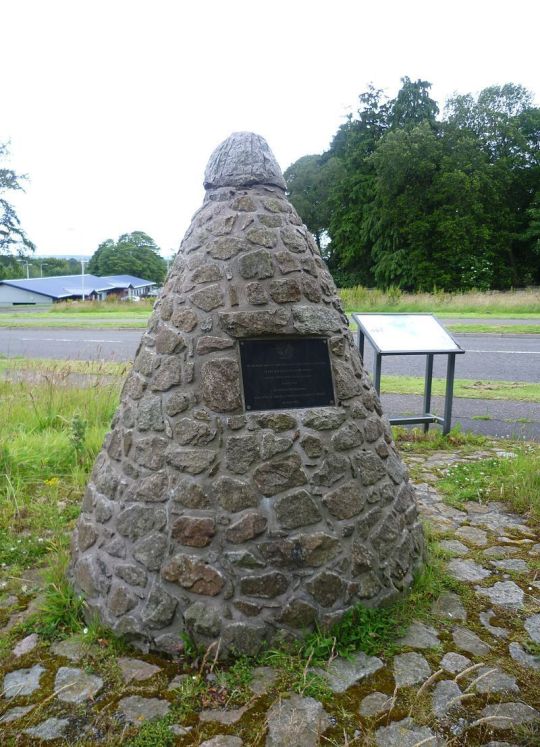


July 20th 1651 saw The Battle of Inverkeithing when Royalist force supporting Charles II failed to halt advance of army of Oliver Cromwell heading for Perth.
It was during the night or early morning of 16th /17th July 1651 that the troops of Oliver Cromwell’s New Model Army landed on the north shore of the Forth in the vicinity of Inverkeithing Bay. Whilst they had inflicted a heavy defeat on the Scottish army at Dunbar on 3rd September 1650, they had been thwarted by attempts to advance further into Scotland. Cromwell came to the conclusion that Fife was the key and by 20th July, 4,500 of Cromwell’s Parliamentarian force were dug in on Ferry Hills, whilst a Scottish force of a similar size had grouped at Castland Hill. The threat of Scottish reinforcements coming from Stirling provoked Cromwell’s Parliamentarians to attack and force the Scottish infantry to retreat north towards Pitreavie Castle.
On land close to the Castle, the Scottish infantry made a final stand but were soon overwhelmed by the more experienced Parliamentarians who had the additional advantage of cavalry. The Scots suffered heavy losses. This became known as The Battle of Inverkeithing (sometimes The Battle of Pitreavie) and was the last major battle of the Wars of the Three Kingdoms in Scotland. From 1652, Scotland was wholly under control of Cromwell’s Protectorate.
Of course the battle was and straightforward as this, there are always stories within the battles themselves, if you remember my Bannockburn posts and more recently yesterdays, where we saw a prominent member of the Douglas Clan killed, Inverkeithing was no different.
Clan Maclean of of Duart, Mull was commanded by their chief, Sir Hector, they found themselves surrounded by superior enemy forces. The clansmen fought fiercely in defence of their chief, calling out, “Fear eile airson Eachainn!” (Another for Hector!), he was supported and covered from their attacks by these intrepid men; and as one brother fell, another came up in succession to cover for him, seven brothers of the clan sacrificed their lives in defence of their leader, they were traditionally Hector’s foster-brothers. He too was killed in the battle that day.
The photo shows the monument at Pitreavie, it reads
Battle of Inverkeithing Memorial
"Near here Sir Hector Maclean of Duart was killed at the Battle of Inverkeithing along with some 760 of his men. 20 July 1651. Another for Hector!*
Erected by the Clan Maclean Heritage Trust 20 July 2001 The day was remembered very vividly for several generations, the Annals of Dunfermline record that….“A rill, traversing the valley, called the Pinkerton-burn,” tradition says, “ran with blood for several days, and the appearance of the little mounds, or heaps of the slain, resembled a hairst field of stooks of corpses.” *harvest field of stacked sheaves
31 notes
·
View notes
Photo
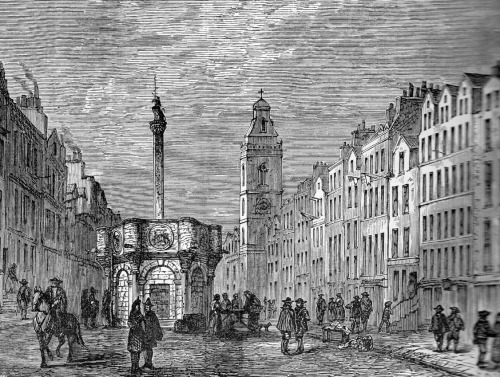

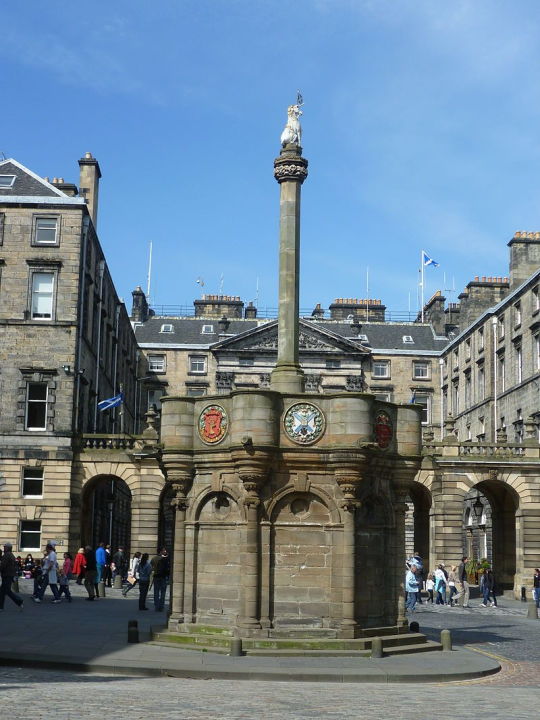
On 4th February 1652 Oliver Cromwell's "Tender of Union"was announced at the Mercat Cross in Edinburgh, this led to the first Union of Scotland and England.
Cromwells new model army had invaded Scotland, winning decisive battles against the Scots at battles of Dunbar and Inverkeithing, this Proclamation in Edinburgh was made to draw a line under Wars of the Three Kingdoms. Oliver Cromwell was installed as the Lord Protector of the Commonwealth of England, Scotland and Ireland and he ordained that the People of Scotland were pardoned for any crimes they might have committed during the preceding wars and that there would be not further financial or other punishments.
There were of course exceptions, any Royalty were still to be held to account as were over two dozen Scottish nobles and generals including David Leslie Lieutenant-General of the Scottish Army. Over 70 other nobles who had been fined by Cromwell were still held to those penalties.
Scotland was placed under English military occupation with General Monck as military governor of the country. The English army had been able to suppress the Scottish resistance to the occupation with relative ease and the occupation, with sporadic but ineffective resistance, this continued until 1660 when Monk was instrumental in the restoration of the monarchy and Charles II was invited to take the throne.
10 notes
·
View notes
Photo
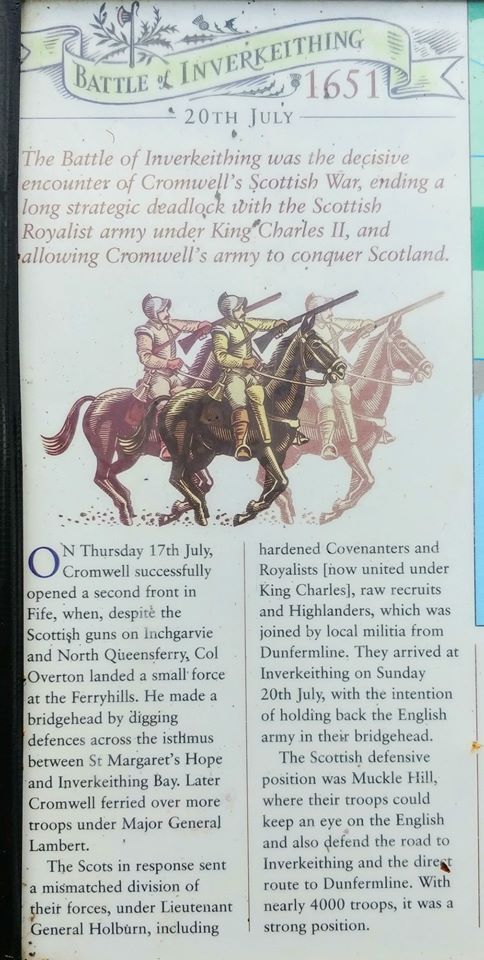
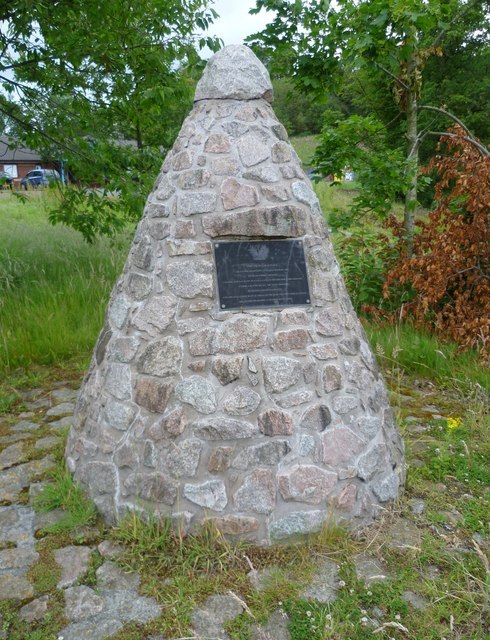

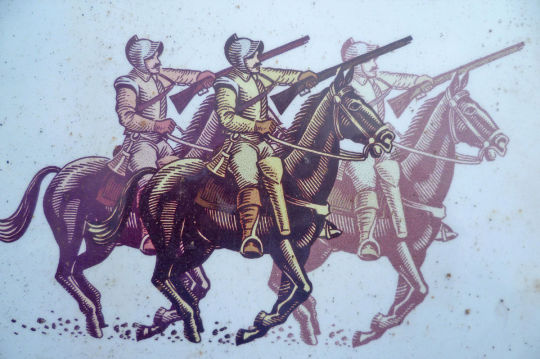
The Battle of Inverkeithing, took place on the 20th of July 1651.
The New Model Army led by Parliamentary officer John Lambert defeated a force of Scottish Royalists under the authority of Sir John Browne.It was a decisive encounter of Cromwell’s Scottish War, ending a long strategic deadlock with the Scottish Royalist army under King Charles II, and allowing them to conquer Scotland.
Oliver Cromwell, England’s Lord Protector, had ordered Lambert to cross the Firth of Forth into Fife with 4,500 troops and attack David Leslie, Lord Newark’s supply lines. In response to this threat, Leslie had sent Browne’s 4,000 men-at-arms to drive Lambert back over the Firth. The hostilities began with skirmishes at Inverkeithing.
As Lambert’s Roundheads moved northward, a major battle took place on the flat terrain south of Pitreavie House. In the aftermath, the Scots had suffered a terrible defeat with up to 2,000 killed, many wounded and 500 taken prisoner. One of the prisoners was the Royalist commander himself, Sir John Browne. Another notable casualty was our own Sir Hector MacLean of Duart who tragically died along with some 760 of the gallant MacLean contingent.
The day was remembered very vividly for several generations, the Annals of Dunfermline record that….“A rill, traversing the valley, called the Pinkerton-burn,” tradition says, “ran with blood for several days, and the appearance of the little mounds, or heaps of the slain, resembled a hairst field of stooks of corpses.”
In honour of Sir Hector and his men, the Clan MacLean Heritage Trust raised this monument on the site of the battle - exactly 350 years later - on the 20th of July 2001.
18 notes
·
View notes